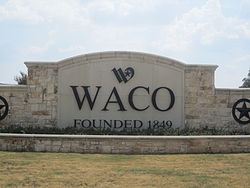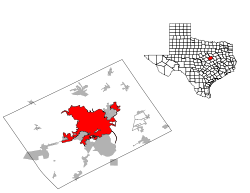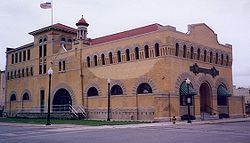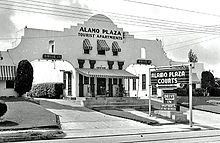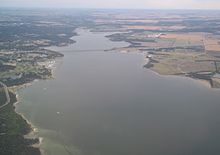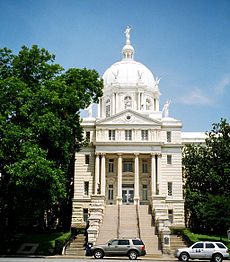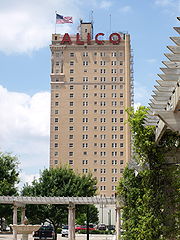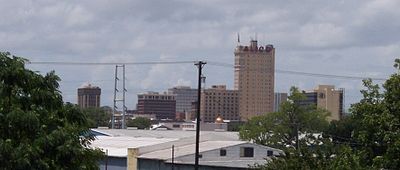- Waco, Texas
-
"Waco" redirects here. For the siege near Waco, Texas, see Waco siege. For the steamship, see City of Waco. For other uses, see Waco (disambiguation).
City of Waco — City — Waco welcome sign
FlagNickname(s): Heart of Texas Location in Texas Coordinates: 31°33′5″N 97°9′21″W / 31.55139°N 97.15583°WCoordinates: 31°33′5″N 97°9′21″W / 31.55139°N 97.15583°W Country  United States
United StatesState  Texas
TexasCounty McLennan Government – Type Council-Manager – City Council Mayor Jim Bush
Wilbert Austin, Sr.
Alice Rodriguez
Randy Riggs
Toni Herbert
Malcolm Duncan Jr.– City Manager Larry D. Groth, P.E. Area – City 95.5 sq mi (247.4 km2) – Land 84.2 sq mi (218.1 km2) – Water 11.3 sq mi (29.3 km2) 11.85% Elevation 470 ft (143.3 m) Population (2010) – City 124,805 – Density 1,350/sq mi (521.5/km2) – Metro 233,378 Time zone Central (UTC-6) – Summer (DST) Central (UTC-5) ZIP codes 76700-76799 Area code(s) 254 FIPS code 48-76000[1] GNIS feature ID 1370701[2] Website http://www.waco-texas.com/ Waco (/ˈweɪkoʊ/) is a city in and the county seat of McLennan County, Texas. Situated along the Brazos River and on the I-35 corridor, halfway between Dallas and Austin, it is the economic, cultural, and academic center of the 'Heart of Texas' region.
The city has a 2010 population of 124,805 - an increase of almost 10 percent since the 2000 census.[3] The Waco Metropolitan Statistical Area consists of just McLennan County, which has a 2010 population of 234,906.[4]
Contents
History
1824–1865
Prior to the founding of Waco in 1849, a Wichita Native American group known as the "Waco" (Spanish: Hueco or Huaco) lived on the land of present-day downtown Waco. In 1824 Thomas M. Duke explored the area and reported to Stephen F. Austin describing the village: "This town is situated on the West Bank of the River. They have a spring almost as cold as ice itself. All we want is some Brandy and Sugar to have Ice Toddy. They have about 400 acres (1.6 km2) planted in corn, beans, pumpkins, and melons and that tended in good order. I think they cannot raise more than One Hundred Warriors." After Austin aborted the first attempt to destroy their village in 1825, he made a treaty with them. The Waco eventually moved out of the region, settling north near present-day Fort Worth. In 1872 they joined other Wichita tribes on a reservation in Oklahoma. In 1902 the Waco received allotments of land and became official US citizens.
Neil McLennan settled in an area near the South Bosque River in 1838.[5] Jacob De Cordova bought McLennan's property[6] and hired a former Texas Ranger and surveyor named George B. Erath to inspect the area.[7] In 1849, Erath designed the first block of the city. Property owners wanted to name the city Lamartine, but Erath convinced them to name the area Waco Village, in honor of the Native Americans who had lived there.[citation needed] In March 1849, Shapley Ross built the first house in Waco, a double-log cabin, on a bluff overlooking the springs. His daughter Kate soon became the first white child to be born in Waco.[8]
1866–1900
In 1866, Waco's leading citizens embarked on an ambitious project to build the first bridge to span the wide Brazos River. They formed the Waco Bridge Company to build the 475-foot (145 m) brick Waco Suspension Bridge, which was called the longest span of any bridge west of the Mississippi River when completed in 1870. The company commissioned a firm owned by John Augustus Roebling in Trenton, New Jersey to supply the cables and steelwork for the bridge, which was a pioneering engineering feat of the era. Roebling's firm began work on the Brooklyn Bridge in 1870. The economic effects of the Waco bridge were immediate and large, attracting cattle runs from the nearby Chisholm Trail and increasing the population of the city, as immigrants now had a safe passage for their horse drawn carriages to cross the river. Since 1971, the bridge has been open only to pedestrian traffic and is in the National Register of Historic Places.
In the late 19th century a red light district called the "Reservation" grew up in Waco and prostitution was regulated by the city. The Reservation was suppressed in the early 20th century. In 1885, the soft drink Dr Pepper was invented in Waco at Morrison's Old Corner Drug Store.
In 1873, AddRan College was founded by brothers Addison and Randolph Clark in Fort Worth. The school moved to Waco in 1895, changing its name to Add-Ran Christian University and taking up residence in the empty buildings of Waco Female College. Add-Ran changed its name to Texas Christian University in 1902 and left Waco after the school's main building burned down in 1910. TCU was offered a 50-acre (200,000 m2) campus and $200,000 by the city of Fort Worth to relocate there. In 1845, Baylor University was founded in Independence, Texas, making it the oldest institution of higher learning in the state of Texas. It moved to Waco in 1886 and merged with Waco University, becoming an integral part of the city. The university's Strecker Museum was also the oldest continuously operating museum in the state until it closed in 2003, and the collections were moved to the new Mayborn Museum Complex.
In the 1890s, William Cowper Brann published the highly successful Iconoclast newspaper in Waco. One of his targets was Baylor University. Brann revealed that Baylor officials had been importing South American children recruited by missionaries and making house-servants out of them. Brann was shot in the back by Tom Davis, a Baylor supporter. Brann then wheeled, drew his pistol, and killed Davis. Brann was helped home by his friends, and died there of his wounds.
In 1894, the first Cotton Palace fair and exhibition center was built to reflect the dominant contribution of the agricultural cotton industry in the region. Since the end of the Civil War, cotton had been cultivated in the Brazos and Bosque valleys, and Waco had become known nationwide as a top producer. Over the next 23 years, the annual exposition would welcome over eight million attendees. The opulent building which housed the month-long exhibition was destroyed by fire and rebuilt in 1910. In 1931, the exposition fell prey to the Great Depression, and the building was torn down. However, the annual Cotton Palace Pageant continues, hosted in late April in conjunction with the Brazos River Festival.
On September 15, 1896 "The Crash" took place about 15 miles (24 km) north of Waco. "The Crash at Crush" was a publicity stunt done by the Missouri-Kansas-Texas Railroad company (known as M-K-T or "Katy"), featuring two locomotives intentionally set to a head-on collision. Meant to be a family fun event with food, games and entertainment, the Crash turned deadly when both boilers exploded simultaneously, sending metal flying in the air. Two people died and six were seriously injured.1901–present
In 1916, an African American teenager named Jesse Washington was tortured, mutilated and burned to death in the town square by a mob that seized him from the courthouse, where he had been convicted of murdering a white woman. 15,000 spectators, mostly citizens of Waco, were present. The commonly-named Waco Horror drew international condemnation and became the cause célèbre of the nascent NAACP's anti-lynching campaign. In 2006, the Waco City Council officially condemned the lynching, which took place without opposition from local political or judicial leaders.
In 1923, the Texas Legislature created the Tenth Civil Court of Appeals and placed it in Waco; it is now known as the 10th Court of Appeals.
In 1937, Grover C. Thomsen and R.H. Roark created a soft-drink called "Sun Tang Red Cream Soda". This would later become known as the soft drink Big Red.
On May 5, 1942, Waco Army Air Field opened as a basic pilot training school and on June 10, 1949, the name was changed to Connally Air Force Base in memory of Col. James T. Connally, a local pilot killed in Japan in 1945. The name changed again in 1951 to the James Connally Air Force Base. The base closed in May of 1966 and is now the location of Texas State Technical College, formerly Texas State Technical Institute, since 1965. The airfield is still in operation and was used by Air Force One when former US President George W. Bush visited his Prairie Chapel Ranch, also known as the Western White House, in Crawford, Texas.
On May 11, 1953, a tornado hit downtown Waco, killing 114. As of 2011, it remains the eleventh deadliest tornado in U.S. history and tied for the deadliest in Texas state history.[9] It was the first tornado tracked by radar and helped spur the creation of a nationwide storm surveillance system.
In 1964 the Texas Department of Public Safety designated Waco as the site for the state-designated official museum of the legendary Texas Rangers law enforcement agency founded in 1823. In 1976 it was further designated the official Hall of Fame for the Rangers and renamed the Texas Ranger Hall of Fame and Museum. Renovations by the Waco government earned this building green status, the first Waco government-led project of its nature. The construction project has also fallen under scrutiny for expanding the building over unmarked human graves.
In 1978, bones were discovered emerging from the mud at the confluence of the Brazos River and the Bosque River. Subsequent excavations revealed that the bones were 68,000 years old and belonged to a species of mammoth. Eventually, the remains of at least 24 mammoths, one camel, and one large cat were found at the site, making it one of the largest findings of its kind. Scholars have puzzled over why such a large herd had been killed all at once. The site is currently being looked at by the National Park Service for possible inclusion into the National Park system. They are conducting a special resource study to be presented to Congress.
On February 28, 1993, there was a shoot out in which six Branch Davidians and four agents of the United States Bureau of Alcohol, Tobacco and Firearms (ATF) died. After 51 days on April 19, 1993 a standoff between FBI agents and Branch Davidians ended in a fire that destroyed their compound located in Mt. Carmel, near Waco. Seventy-four people, including leader David Koresh, died in the blaze.
In 1999, a charter school called the Emma L. Harrison Charter School was closed by the Texas Education Agency; the school was the first school of its kind to have its charter revoked in Texas.[10]
Rock guitarist and outdoorsman Ted Nugent, who is an enthusiastic bowhunter, resides in Waco. He filmed his MTV show "Surviving Nugent" on his ranch in nearby China Spring, Texas.
During the Presidency of US President George W. Bush, Waco was the home to the White House Press Center. The press center provided briefing and office facilities for the press corps whenever Bush visited his "Western White House" in Crawford. The former president's home is an outlying McLennan County community about 20 miles (32 km) west of Waco.
Geography and climate
Waco is located at 31°33'5" North, 97°9'21" West (31.551516, -97.155930).[11]
According to the United States Census Bureau, the city has a total area of 95.5 square miles (247 km2). 84.2 square miles (218 km2) of it is land and 11.3 square miles (29 km2) of it is water. The total area is 11.85% water.
Monthly Normal and Record High and Low Temperatures Month Jan Feb Mar Apr May Jun Jul Aug Sep Oct Nov Dec Rec High °F 88 96 100 101 102 109 109 112 111 101 92 91 Norm High °F 57 62.3 70.2 77.6 84.8 92 96.7 96.9 90.1 80.4 67.8 59.1 Norm Low °F 35.1 39.3 46.8 54.2 63.3 70.6 74.1 73.5 67 56.7 45.8 37.5 Rec Low °F −5 4 15 27 37 52 60 53 40 25 17 −4 Precip (in) 1.9 2.4 2.5 3.0 4.5 3.1 2.2 1.8 2.9 3.7 2.6 2.8 Source: Weather By Day[12] Demographics
Historical populations Census Pop. %± 1870 3,008 — 1880 7,295 142.5% 1890 14,445 98.0% 1900 20,686 43.2% 1910 26,425 27.7% 1920 38,500 45.7% 1930 52,848 37.3% 1940 55,982 5.9% 1950 84,706 51.3% 1960 97,808 15.5% 1970 95,326 −2.5% 1980 101,261 6.2% 1990 103,590 2.3% 2000 113,726 9.8% 2010 124,805 9.7% As of the census[1] of 2000, there were 113,726 people in the city, organized into 42,279 households and 24,775 families. The population density was recorded as 1,350.6 people per square mile (521.5/km2), with 45,819 housing units at an average density of 544.2 per square mile (210.1/km2). The 2000 racial makeup of the city was 60.78% White, 22.65% African American, 1.38% Asian, 0.51% Native American, 0.05% Pacific Islander, 12.38% from other races, and 2.26% from two or more races. 23.64% of the population being Hispanic or Latino of any race.
The census recorded 42,279 households out of which 29.5% had children under the age of 18 living with them, 38.4% having married couples living together, 16.2% having a female householder with no husband present, and 41.4% as non-families. 31.1% of all households were made up of individuals and 10.9% had someone living alone at 65 years of age or older. The average household size was calcultaed as 2.49 and the average family size 3.19.
In the city the population is spread out with 25.4% under the age of 18, 20.3% from 18 to 24, 25.0% from 25 to 44, 16.0% from 45 to 64, and 13.4% who are 65 years of age or older. The median age is 28 years. For every 100 females there are 91.4 males. For every 100 females age 18 and over, there are 87.3 males.
The median income for a household in the city is $26,264, and the median income for a family is $33,919. Males have a median income of $26,902 versus $21,159 for females. The per capita income for the city is $14,584. 26.3% of the population and 19.3% of families are below the poverty line. Out of the total population, 30.9% of those under the age of 18 and 13.0% of those 65 and older are living below the poverty line.
Government
The City of Waco establishes and administers law through a council-manager form of government. Citizens are represented on the City Council by six elected members; five from single-member districts and a mayor who is elected at-large.[13] The city offers a full line of city services typical of an American city this size, including: police, fire, electric utilities, water and wastewater, solid waste, public transportation, to name a few.
The Heart of Texas Council of Governments (HOTCOG) is headquartered in Waco on South New Road. This regional agency is a voluntary association of cities, counties, and special districts in the Central Texas area.
The Texas Tenth Court of Appeals is located in the McLennan County Courthouse in Waco.[14]
The Waco Fire Department operates 14 fire stations throughout the city.[15]
The Texas Department of Criminal Justice (TDCJ) operates the Waco Parole Office in Waco.[16]
The United States Postal Service operates the Waco Main Post Office along Texas State Highway 6.[17] In addition it operates other post offices throughout Waco.
Economics
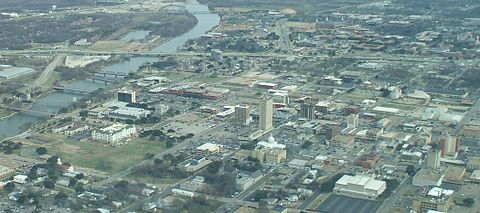 Aerial view of Downtown Waco; Brazos River to the left and campus of Baylor University in the upper right.
Aerial view of Downtown Waco; Brazos River to the left and campus of Baylor University in the upper right.
According to the Waco Chamber of Commerce,[18] the top employers in the city are:
# Employer Employees 1 Providence Health Center 2,434 2 Baylor University 2,360 3 Waco Independent School District 2,350 4 City of Waco 1,729 5 Hillcrest Health System 1,350 6 L-3 Communications 1,619 7 H-E-B 1,350 8 Wal-Mart 1,290 9 Sanderson Farms, Inc. 1,170 10 Midway Independent School District 955 Downtown
The town of Waco was built around the Waco Suspension Bridge, which was a crucial crossing of the Brazos River upon completion in 1870. Today, Downtown Waco is relatively small when compared to other larger Texas cities, such as Houston, Dallas, San Antonio or even Fort Worth, El Paso or Austin. However, each day nearly 20,000 people commute to and from work in downtown. It is also the location of the McLennan County Courthouse.
In May 1953, the worst tornado in Texas history struck downtown Waco killing 114, and injuring hundreds. It caused millions of dollars in damage, and dented Waco's economy for years after. Downtown Waco is home to the ALICO building, which was completed in 1910, and was once the tallest structure in the Southwest. Downtown Waco is also the location of the famous Dr Pepper Museum, where Dr Pepper was invented.
A scenic Riverwalk along the east and west banks of the Brazos River stretches from the Baylor campus to Cameron Park Zoo, about seven miles in all. This multi-use walking and jogging, lighted trail passes underneath the Waco Suspension Bridge and captures the peaceful charm of the Brazos River.[19]
See also: Neighborhoods of WacoEducation
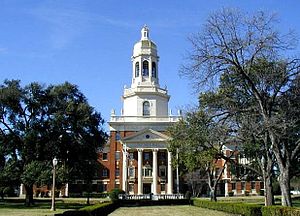 Pat Neff Hall Administration Building, Baylor University
Pat Neff Hall Administration Building, Baylor University
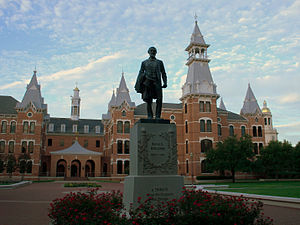 Judge Rufus C. Burleson Statue in front of Burleson Quadrangle at Baylor University
Judge Rufus C. Burleson Statue in front of Burleson Quadrangle at Baylor University
Waco Independent School District serves most of the city of Waco. However, Midway ISD, Connally ISD, China Spring ISD, La Vega ISD and Bosqueville ISD also serve parts of Waco. There are four main high schools in Waco city limits: Waco High School (Waco ISD), A.J. Moore Academy (Waco ISD), University High School (Waco ISD), and Midway High School (Midway ISD). The schools are all major rivals in sports, academics and pride; with the exception of A.J. Moore which does not offer sports.It used to offer swimming in the past, but no longer does. Public charter high schools including Rapoport Academy, EOAC Charter School and Premier High School of Waco serve the McLennan County area. Local private and parochial schools include Vanguard College Preparatory School, Live Oak Classical School, Texas Christian Academy, Parkview Christian Academy, and Reicher Catholic High School.
There are three institutions of higher learning in Waco:
In the past, several other higher education institutions were located in Waco:[20]- AddRan Male & Female College (now Texas Christian University)
- The Catholic College
- The Independent Biblical and Industrial School
- Central Texas College (unrelated to the current school)
- Paul Quinn College
- A&M College
- The Gurley School
- Waco Business College
- Toby's Practical Business College
- Provident Sanatarium
- The Training School
Local media
The major daily newspaper is the Waco Tribune-Herald. Other publications include The Waco Citizen, Tiempo, The Anchor News, U Monthly, Wacoan and The Baylor Lariat.
The Waco television market is the 89th largest television market in the US and includes the following channels:[21] KCEN 6 (NBC), KWTX 10 (CBS), KXXV 25 (ABC), KWKO 38 (Univision), KWKT 44 (Fox)
The Waco radio market is the 200th largest radio market in the US
Transportation
Interstate 35 is the major north-south highway for Waco. It directly connects the city with Dallas(I-35E), Fort Worth (I-35W), Austin and San Antonio.
State Highway 6 runs northwest-southeast and connects Waco to Bryan/College Station and Houston. US Highway 84 is the major east-west thoroughfare in the area. It is also known as Waco Drive, Bellmead Drive, Woodway Drive or the George W. Bush parkway. Loop 340 bypasses the city to the east and south. State Highway 31 splits off of US-84 just east of Waco and connects the city to Tyler, Longview and Shreveport, LA.
The Waco area is home to three airports. Waco Regional Airport (ACT) serves the city with daily flights to D/FW International via American Eagle and to Houston's Bush Intercontinental via Continental Connection. TSTC Airport (CNW) is the former site of James Connally AFB and was the primary fly-in point for former President George W. Bush when he was visiting his ranch in Crawford, TX. It is also a hub airport for L3 and several other aviation companies. McGregor Executive Airport (PWG) is a general aviation facility located west of Waco.
Local transportation is provided by the Waco Transit System, which offers bus service Monday-Saturday to most of the city. Taxi service is provided by Yellow Cab.
Train service is offered through Amtrak. The Texas Eagle route includes daily stops in McGregor, just west of the city.
Attractions
Major Waco attractions include:
- Armstrong Browning Library
- Baylor University
- Cameron Park Zoo
- Dr Pepper Museum
- Lake Waco
- Grand Lodge of Texas
- Mayborn Museum Complex
- The Ranger wing of the Commemorative Air Force
- Texas Ranger Hall of Fame and Museum
- Texas Sports Hall of Fame
- Texas State Technical College
- Waco Mammoth Site [3]
- Waco Suspension Bridge
Professional sports
 Extraco Events Center in Waco (formerly the Heart O' Texas Coliseum)
Extraco Events Center in Waco (formerly the Heart O' Texas Coliseum)
The American Basketball Association had a franchise for part of the 2006 season, the Waco Wranglers. The team played at Reicher Catholic High School and practiced at Texas State Technical College.Previous professional sports franchises in Waco have proven unsuccessful. The Waco Marshals of the National Indoor Football League lasted less than two months amidst a midseason ownership change in 2004. (The team became the beleaguered Cincinnati Marshals the following year.) The Waco Wizards of the now-defunct Western Professional Hockey League fared better, lasting into a fourth season before folding in 2000. Both teams played at the Heart O' Texas Coliseum, one of Waco's largest entertainment and sports venues.
The SIFL (Southern Indoor Football League) announced that Waco is an expansion market for the 2010 season. It is rumored that they will play in the Heart O' Texas Coliseum.
Professional baseball first came to Waco in 1889 with the formation of the Waco Tigers, a member of the Texas League. The Tigers were renamed the Navigators in 1905, and later to the Steers. In 1920, the team was sold to Wichita Falls. In 1923, a new franchise called the Indians was formed and became a member of the Class D Texas Association. In 1925, Waco rejoined the Texas League with the formation of the Waco Cubs.
On June 20, 1930, the first night game in Texas League history was played at Katy Park in Waco. The lights were donated by Waco resident, Charles Redding Turner, who owned a local farm team for recruits to the Chicago Cubs.
On the night of August 6, 1930, baseball history was made at Katy Park: in the eighth inning of a night game against Beaumont, Waco left fielder Gene Rye became the only player in the history of professional baseball to hit three home runs in one inning.
1930 was the last year that Waco had a team in the Texas League, but Waco fielded some strong semi-pro teams in the 1930s and early 1940s. During the World War II years of 1943-45, the powerful Waco Army Air Field team was probably the best in the state; many major leaguers played for the team, and it was managed by big league catcher Birdie Tebbetts.
In 1947, the Class B Big State League was organized with Waco as a member called The Waco Dons.
In 1948, A.H. Kirksey, owner of Katy Park, persuaded the Pittsburgh Pirates Professional club to take over the Waco operation and the nickname was changed to Pirates. The Pirates vaulted into third place in 1948. They dropped a notch to fourth in 1949, but prevailed in the playoffs to win the league championship. The Pirates then tumbled into the second division, bottoming out with a dreadful 29-118, 0.197 club in 1952. This mark ranks as one of the 10 worst marks of any 20th century full-season team. When the tornado struck in 1953, it destroyed the park. The team relocated to Longview, Texas to finish the season and finished a respectable third with a 77-68 record.
Notable people
See also: List of Baylor University peopleSports
- Lance Berkman, born in Waco, is a Major League Baseball player for the St. Louis Cardinals.
- Kwame Cavil, born in Waco, is a Canadian Football League wide receiver for the Edmonton Eskimos.
- Zach Duke, graduated from Midway High School in Waco, is a Major League Baseball player for the Pittsburgh Pirates.
- Dave Eichelberger, born in Waco, is an American professional golfer who has won several tournaments at both the PGA Tour and Champions Tour levels.
- Casey Fossum, graduated from Midway High School in Waco, is a Major League Baseball player for the New York Mets.
- Ken Grandberry, born in Waco, is a former National Football League running back for the Chicago Bears.
- Andy Hawkins, born in Waco, is a former major-league pitcher.
- Sherrill Headrick, born in Waco, came to the American Football League's Dallas Texans as an undrafted linebacker.
- Heath Herring, born in Waco, is a mixed martial arts fighter.
- Neal Jeffrey, former All-American quarterback at Baylor University and NFL quarterback for the San Diego Chargers.
- Derrick Johnson, NFL football player for the Kansas City Chiefs.
- Michael Johnson, United States sprinter; graduated from Baylor University in 1990.
- Rob Powell (Fitness Coach), is a Fitness Coach and has 2 Certificates of Guinness World Records
- Dominic Rhodes, born in Waco, is an American football running back who currently plays for the Buffalo Bills.
- Bill Rogers, born in Waco, is best known as the winner of the 1981 British Open.
- George Sauer, Jr., graduated from Waco High School, and was a wide receiver with the New York Jets.
- LaDainian Tomlinson, NFL football player for the New York Jets; born in Rosebud, grew up in Waco, and went to University High School.
- Perrish Cox, NFL cornerback for the Denver Broncos; born in Waco, grew up in Waco, and went to University High School.
- Cameron Wake, born in Waco, is a National Football League defensive end for the Miami Dolphins
- Jeremy Wariner, former All-American for Baylor University Track and Field
- Darold Williamson, former All-American for Baylor University Track and Field
- Pro Baseball Players from Waco
- Kevin Belcher 8/8/1967 CF-RF MLB 1990–1990
- Lance Berkman 2/10/1976 LF-RF MLB 1999–2006
- Buzz Dozier 8/31/1927 P MLB 1947–1949
- Louis Drucke 12/3/1888 P MLB 1909–1912
- Boob Fowler 11/11/1900 SS MLB 1923–1926
- Charlie Gorin 2/6/1928 P MLB 1954–1955
- Donald Harris 11/12/1967 CF-RF MLB 1991–1993
- Andy Hawkins 1/21/1960 P MLB 1982–1991
- Al Jackson 12/25/1935 P MLB 1959–1969
- Scott Jordan 5/27/1963 CF MLB 1988–1988
- Rudy Law 10/7/1956 OF MLB 1978–1986
- Dutch Meyer 10/6/1915 2B MLB 1940–1946
- Arthur Rhodes 10/24/1969 P MLB 1991–2006
- Schoolboy Rowe 1/11/1910 P MLB 1933–1949
- Ted Wilborn 12/16/1958 OF MLB 1979–1980
Movies
- Jules Bledsoe Stage & Screen Actor and Singer., When the Broadway premiere of Show Boat was delayed in 1927 by Ziegfeld, Paul Robeson became unavailable, so Jules Bledsoe stepped in. He played and sang the role of Joe, introducing "Ol' Man River".
- James Brown, film and television star; appeared as Lieutenant Ripley "Rip" Masters in 166 episodes of ABC's The Adventures of Rin Tin Tin (1954–1959) and later as detective Harry McSween on CBS's Dallas
- Shannon Elizabeth of American Pie fame was born in Houston and grew up in Waco.
- Peri Gilpin, best known for her television character Roz Doyle on the hit series Frasier, was born in Waco and raised in Dallas.
- Texas Guinan was a Hollywood actress from 1917 to 1933. She was active in vaudeville and theater, and was in many movies (often as the gun-toting hero in silent westerns, more than a match for any man). She also had a successful career as a hostess in night clubs and speakeasies in New York City.
- Thomas Harris, author of The Silence of the Lambs, was a student at Baylor University, and covered the police beat for the Waco Tribune-Herald.
- Jennifer Love Hewitt, born in Waco.
- Terrence Malick, director of The Thin Red Line, was born in Waco. He also directed The Tree of Life which was set in the town of Waco in the 1950s.
- Comedian Steve Martin was born in Waco; his family moved to California when he was around six years old.
- Director Kevin Reynolds (Robin Hood: Prince of Thieves, The Count of Monte Cristo, Waterworld) was born and raised in Waco.
Music
- David Crowder Band, a Christian worship band, is from Waco.
- Pat Green, Country music singer/songwriter, was raised in Waco and his parents still reside there.
- Roy Hargrove, a Grammy Award-winning jazz trumpeter, was born and raised in Waco.
- Hi-Five, a successful R&B group who had hits in the 1990s including "I Like The Way (The Kissing Game)", is from Waco.
- Kari Jobe, a two-time Dove Award winning Christian singer-songwriter was born in Waco and was raised in Watauga, Texas and Hurst, Texas.
- Willie Nelson, country music singer/songwriter was born in nearby Abbott, Texas and attended Baylor University for one year.
- Ted Nugent along with his wife Shemane and son Rocco Nugent live in Waco
- Bill Payne, keyboardist for the rock band Little Feat born and raised in the Waco area.
- Billy Joe Shaver, country songwriter ("Honky Tonk Heroes") and singer ("Old Chunk of Coal"), lives in Waco.
- Ashlee Simpson, pop music singer, was born in Waco and raised in Dallas.
- Jessica Simpson, pop music singer, was born in Abilene and raised in Waco and Dallas.
- Strange Fruit Project, an underground hip hop trio, is from Waco.
- Hank Thompson, was born in Waco and is a country music singer who was inducted into the Country Music Hall of Fame and Nashville Songwriters Hall of Fame.
- Fisher Tull, composer (1934–1994)
- Rufus Johnson, member of the hip-hop group D12 from Detroit, Michigan, announced in a D12 song from the album Devil's Night entitled "American Psycho" that he is "Moving to Waco, Texas" with his girlfriend.
- Mercy Dee Walton was born in Waco.
- Tres Womack, Award winning Texas music singer/songwriter. Winner: Song of the Year "Gather Round" 2008 Texas Music Awards, also nominated for Album of the Year honors for "Freak Show". Oldest brother of Drew Womack. Graduate and former Head Baseball Coach for Howard Payne University. Nephew of former Howard Payne University President Guy Newman, lives in Waco.
- Tom Wilson, 1960s record producer
Politics
- Kip Averitt, State senator from District 22 from 2002 to 2010
- Joe Barton, a US congressman representing Texas's 6th congressional district in the U.S. House of Representatives, was born and reared in Waco.
- Roy Bass, Waco native who served as mayor of Lubbock (1974–1978)
- Jessica Craig, former Oklahoma state senator who authored legislation involving federal care of senior citizens
- Russell B. Cummings, member of the Texas House of Representatives from Harris County, 1963–1967; retired to Waco
- Chet Edwards, former U.S. representative
- Kent Grusendorf, former state representative from Arlington, originally from Waco
- Leon Jaworski, who prosecuted Nazi war criminals during the Nuremberg trials and then was the special prosecutor who brought down the Nixon administration during the Watergate scandal, was born and raised in Waco.
- Billy G. Mills (born 1929), Los Angeles City Council member, 1963–74, Superior Court judge thereafter
- Albert Parsons, a radical labor organizer hanged for his role in Chicago's Haymarket Riot (but posthumously exonerated). During Reconstruction, he attended Waco University (now Baylor) and published a pro-civil rights newspaper in Waco. He moved to Chicago after marrying activist Lucy Waller.
- Ann Richards, former governor of Texas and keynote speaker at the 1988 Democratic National Convention, was born in the Waco suburb of Lacy-Lakeview and graduated from Baylor University.
- David McAdams Sibley, Sr., former state senator (1991–2002) and mayor of Waco (1987–1988)
Other
- T. Berry Brazelton, born in Waco, is a noted pediatrician and author. Major hospitals throughout the world use the Brazelton Neonatal Behavioral Assessment Scale(NBAS).
- Dr. Allen Bussey, a Waco resident, set a yo-yo world record with 20,302 consecutive loops on April 23, 1977. [4]
- Heloise, of the "Hints from Heloise" column, was born in Waco. Her column addresses lifestyle hints, including consumer issues, pets, travel, food, home improvement, health and much more.
- David Koresh, leader of the Branch Davidians, died along with 75 others in the blaze during the Waco Siege, in the town of Elk, nine miles (14 km) away.
- Robert W. McCollum (1925–2010), virologist who made important discoveries regarding polio and hepatitis.[22]
- Glenn McGee, born in Waco, is an internationally noted bioethicist, syndicated columnist for Hearst Newspapers and for The Scientist and scholar.
- Doris (Dorie) Miller, born in Waco, was an African American cook in the United States Navy and a hero during the attack on Pearl Harbor on December 7, 1941. He was the first African American to be awarded the Navy's second highest honor, the Navy Cross. Actor Cuba Gooding Jr. portrayed Miller in the 2001 movie Pearl Harbor.
- C. Wright Mills, born in Waco, was a noted sociologist. Among other topics he was concerned with the responsibilities of intellectuals in post-World War II society, and advocated relevance and engagement over disinterested academic observation.
- W. Winfred Moore, Baptist clergyman lived in Waco during the 1990s, while he was a visiting distinguished professor of religion and director of the Center for Ministry Effectiveness at Baylor.
- Felix Huston Robertson, born in Washington-on-the-Brazos, was a former Confederate Civil War general who became a wealthy lawyer, railroad director, and land speculator in Waco during Reconstruction.
- Antwone Taulton, Homeless Advocate, was raised in Waco.
- Robert Wilson, born in Waco, is an internationally acclaimed stage director.
- Korey Coleman, born in Waco, is a film and video game critic as well as an animator. He created the website Spill.com.
See also
- Neighborhoods of Waco
- Waco Mammoth Site
- Waco Tribune-Herald, the local newspaper
- Brazos Belle
References
- ^ a b "American FactFinder". United States Census Bureau. http://factfinder.census.gov. Retrieved 2008-01-31.
- ^ "US Board on Geographic Names". United States Geological Survey. 2007-10-25. http://geonames.usgs.gov. Retrieved 2008-01-31.
- ^ American FactFinder, United States Census Bureau Retrieved 2011-11-01.
- ^ American FactFinder, United States Census Bureau Retrieved 2011-11-01.
- ^ TSHA Online - About Us - Error - Please update your link to TSHA
- ^ TSHA Online - About Us - Error - Please update your link to TSHA
- ^ TSHA Online - About Us - Error - Please update your link to TSHA
- ^ Davis, Joe Tom (1989). Legendary Texians, Vol. 4. Austin, Texas: Eakin Press. p. 151. ISBN 0890156697
- ^ Top Ten US Killer Tornadoes
- ^ An F for Effort: Texas Monthly December 1999
- ^ "US Gazetteer files: 2010, 2000, and 1990". United States Census Bureau. 2011-02-12. http://www.census.gov/geo/www/gazetteer/gazette.html. Retrieved 2011-04-23.
- ^ "Weather in Waco Texas". Weather By Day. http://www.weatherbyday.com/texas/waco/. Retrieved May 29, 2009.
- ^ "[1]." City of Waco
- ^ "Contact Information." Texas Tenth Court of Appeals. Retrieved on March 10, 2010.
- ^ Waco Fire Stations
- ^ "Parole Division Region IV." Texas Department of Criminal Justice. Retrieved on May 21, 2010.
- ^ "Post Office Location - WACO." United States Postal Service. Retrieved on May 21, 2010.
- ^ http://www.wacochamber.com/EDimages2/MajorWacoEmployer.pdf
- ^ 'City of Waco'[2]
- ^ "The Waco Horror". The Crisis. June 1916. http://www.uncp.edu/home/berrys/courses/hist362/hist362_docs_waco_lynching.pdf. Retrieved 2009-11-03.
- ^ "Local Television Market Universe Estimates" (PDF). The Nielsen Company. http://blog.nielsen.com/nielsenwire/wp-content/uploads/2009/08/2009-2010-dma-ranks.pdf. Retrieved January 25, 2011.
- ^ Hevesi, Dennis. "Robert W. McCollum, Dean of Dartmouth Medical School, Dies at 85", The New York Times, September 25, 2010. Accessed September 26, 2010.
External links
- The official website of Waco, Texas
- The Waco Mammoth Site
- Waco History Project
- Waco, Texas from the Handbook of Texas Online
- The Great Waco Train Wreck
- Waco Convention Center
- Info on Waco's Development
- [5]
- Waco's Semi-Pro Football Teams Website
- Texas Brazos Trail [6]
Municipalities and communities of McLennan County, Texas County seat: WacoCities Bellmead | Beverly Hills | Bruceville-Eddy‡ | Gholson | Golinda‡ | Hallsburg | Hewitt | Lacy Lakeview | Leroy | Lorena | Mart‡ | McGregor‡ | Moody | Riesel | Robinson | Ross | Valley Mills‡ | Waco | West | Woodway
Town Unincorporated
communitiesAxtell | China Spring | Elm Mott | Ocee | Speegleville
Footnotes ‡This populated place also has portions in an adjacent county or counties
County seats of Texas A B Baird · Ballinger · Bandera · Bastrop · Bay City · Beaumont · Beeville · Bellville · Belton · Benjamin · Big Lake · Big Spring · Boerne · Bonham · Boston · Brackettville · Brady · Breckenridge · Brenham · Brownfield · Brownsville · Brownwood · Bryan · BurnetC Caldwell · Cameron · Canadian · Canton · Canyon · Carrizo Springs · Carthage · Center · Centerville · Channing · Childress · Clarendon · Clarksville · Claude · Cleburne · Coldspring · Coleman · Colorado City · Columbus · Comanche · Conroe · Cooper · Corpus Christi · Corsicana · Cotulla · Crane · Crockett · Crosbyton · Crowell · Crystal City · CueroD E F Fairfield · Falfurrias · Farwell · Floresville · Floydada · Fort Davis · Fort Stockton · Fort Worth · Franklin · FredericksburgG Gail · Gainesville · Galveston · Garden City · Gatesville · George West · Georgetown · Giddings · Gilmer · Glen Rose · Goldthwaite · Goliad · Gonzales · Graham · Granbury · Greenville · Groesbeck · Groveton · GuthrieH Hallettsville · Hamilton · Haskell · Hebbronville · Hemphill · Hempstead · Henderson · Henrietta · Hereford · Hillsboro · Hondo · Houston · HuntsvilleJ K L M N O P Paducah · Paint Rock · Palestine · Palo Pinto · Panhandle · Paris · Pearsall · Pecos · Perryton · Pittsburg · Plains · Plainview · Port Lavaca · PostQ R Rankin · Raymondville · Refugio · Richmond · Rio Grande City · Robert Lee · Roby · Rockport · Rocksprings · Rockwall · RuskS San Angelo · San Antonio · San Augustine · San Diego · San Marcos · San Saba · Sanderson · Sarita · Seguin · Seminole · Seymour · Sherman · Sierra Blanca · Silverton · Sinton · Snyder · Sonora · Spearman · Stanton · Stephenville · Sterling City · Stinnett · Stratford · Sulphur Springs · SweetwaterT, U V, W, Z Van Horn · Vega · Vernon · Victoria · Waco · Waxahachie · Weatherford · Wellington · Wharton · Wheeler · Wichita Falls · Woodville · ZapataBranch Davidians Leadership History Apocalypticism · Cult suicide · Millennialism · Seventh-day Adventist Church · Seven seals · Shepherd's Rod · Waco, Texas · Mount Carmel CenterWaco siege Investigation Books From the Ashes: Making Sense of Waco · The Ashes of Waco: An Investigation · Why Waco?: Cults and the Battle for Religious Freedom in America · A Place Called Waco: A Survivor's Story · Armageddon in Waco: Critical Perspectives on the Branch Davidian ConflictDocumentaries In the Line of Duty: Ambush at Waco · Waco: The Big Lie · Waco II: The Big Lie Continues · Waco: The Rules of Engagement · Waco: A New Revelation · Waco: An Apparent Deviation · Day 51: The True Story of Waco · America Wake Up (Or Waco) · The Assault on Waco · Inside WacoMayors of cities with populations exceeding 100,000 in Texas - Annise Parker (Houston)
- Julian Castro (San Antonio)
- Mike Rawlings (Dallas)
- Lee Leffingwell (Austin)
- Betsy Price (Fort Worth)
- John Cook (El Paso)
- Robert Cluck (Arlington)
- Joe Adame (Corpus Christi)
- Phil Dyer (Plano)
- Raul Gonzalez Salinas (Laredo)
- Tom Martin (Lubbock)
- Ronald E. Jones (Garland)
- Beth Van Duyne (Irving)
- Debra McCartt (Amarillo)
- Tony Martinez (Brownsville)
- Charles England (Grand Prairie)
- Johnny Isbell (Pasadena)
- John Monaco (Mesquite)
- Richard F. Cortez (McAllen)
- Ron Branson (Carrollton)
- Virginia DuPuy (Waco)
- Bill Whitfield (McKinney)
- Mark Burroughs (Denton)
- Timothy L. Hancock (Killeen)
- Norm Archibald (Abilene)
- Becky Ames (Beaumont)
- Wes Perry (Midland)
- Alan McGraw (Round Rock)
- Dean Ueckert (Lewisville)
- Bill Keffler (Richardson)
- Lanham Lyne (Wichita Falls)
- Larry Melton (Odessa)
 Other states: AL • AK • AZ • AR • CA • CO • CT • DE • FL • GA • HI • ID • IL • IN • IA • KS • KY • LA • ME • MD • MA • MI • MN • MS • MO • MT • NE • NV • NH • NJ • NM • NY • NC • ND • OH • OK • OR • PA • RI • SC • SD • TN • TX • UT • VT • VA • WA • WV • WI • WYCategories:
Other states: AL • AK • AZ • AR • CA • CO • CT • DE • FL • GA • HI • ID • IL • IN • IA • KS • KY • LA • ME • MD • MA • MI • MN • MS • MO • MT • NE • NV • NH • NJ • NM • NY • NC • ND • OH • OK • OR • PA • RI • SC • SD • TN • TX • UT • VT • VA • WA • WV • WI • WYCategories:- Waco siege
- Waco, Texas
- Cities in Texas
- County seats in Texas
- Populated places established in 1849
Wikimedia Foundation. 2010.

